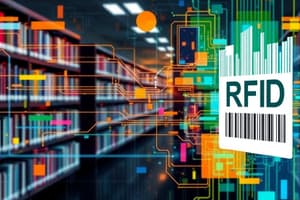Podcast
Questions and Answers
What is the primary purpose of library automation systems?
What is the primary purpose of library automation systems?
- To provide personalized assistance to patrons
- To manage online public access catalogs
- To improve efficiency and accuracy in library operations (correct)
- To support research and information literacy
What is the main function of an Integrated Library System (ILS)?
What is the main function of an Integrated Library System (ILS)?
- To manage circulation and cataloging processes
- To support information literacy and research
- To provide online public access to library resources
- To consolidate various library functions into a single platform (correct)
What is the primary benefit of using Online Public Access Catalogs (OPACs)?
What is the primary benefit of using Online Public Access Catalogs (OPACs)?
- To increase the efficiency of librarians
- To enhance the discovery experience for patrons (correct)
- To improve cataloging and classification processes
- To support circulation management and acquisitions
What is the role of cataloging in library automation?
What is the role of cataloging in library automation?
What is the main goal of circulation management in library automation?
What is the main goal of circulation management in library automation?
What is the relationship between classification and cataloging in library automation?
What is the relationship between classification and cataloging in library automation?
What is the primary function of an OPAC in a library automation system?
What is the primary function of an OPAC in a library automation system?
Which of the following is a key benefit of automated circulation management in library automation systems?
Which of the following is a key benefit of automated circulation management in library automation systems?
What is the primary purpose of metadata in an OPAC?
What is the primary purpose of metadata in an OPAC?
Which of the following is a key feature of library automation systems in terms of cataloging and classification?
Which of the following is a key feature of library automation systems in terms of cataloging and classification?
What is the primary goal of data-driven decision-making in library automation systems?
What is the primary goal of data-driven decision-making in library automation systems?
Which of the following is a key benefit of library automation systems in terms of library management?
Which of the following is a key benefit of library automation systems in terms of library management?
Flashcards are hidden until you start studying
Study Notes
Library software, also known as library automation software, is a set of computer programs designed to streamline and manage various aspects of library operations. These systems are essential for libraries of all types and sizes, as they help manage the organization, circulation, and accessibility of library resources. In this article, we will explore the subtopics of library automation, online public access catalogs (OPACs), circulation management, cataloging, and classification, and how library software addresses these areas.
Library Automation
Library automation refers to the use of computerized systems to manage various aspects of library operations, such as cataloging, circulation, and acquisitions. Library automation systems are designed to improve efficiency and accuracy, allowing librarians to focus on core responsibilities like supporting research, fostering information literacy, and providing personalized assistance to patrons. These systems often include features like integrated library systems (ILS), which consolidate various library functions into a single platform, and stand-alone information retrieval applications that can be integrated with the ILS.
Online Public Access Catalogs (OPACs)
The Online Public Access Catalog (OPAC) is the gateway for users to explore a library's resources. OPACs provide intuitive search capabilities, browse options, and filters to enhance the discovery experience, making it easier for patrons to find what they are searching for. The OPAC algorithms work behind the scenes to retrieve relevant results when a patron types in a keyword or topic. The OPAC displays the availability status of each resource, providing more information to help patrons make informed choices. The OPAC also includes metadata, which acts as a brief description or summary of each resource.
Circulation Management
Efficient circulation workflows are crucial for a seamless library experience. Library automation systems streamline this process by automating checkouts, returns, renewals, and holds. These systems also provide comprehensive patron management features, allowing librarians to maintain accurate records, track borrowing history, manage fines, and personalize services to meet individual needs, such as allowing for payment of fines online.
Cataloging and Classification
Effective cataloging is essential for organizing and retrieving resources. Library automation systems offer robust cataloging tools that simplify the creation, maintenance, and discovery of bibliographic records. Through metadata management, librarians can efficiently classify and describe items, ensuring accurate and consistent information for both staff and users. Library automation systems also help librarians manage acquisitions, from budget planning and generating purchase orders to coordinating with suppliers and tracking deliveries.
Reporting and Analytics
Data-driven decision-making is a fundamental aspect of managing a modern library. Library automation systems provide comprehensive reporting and analytics tools, allowing librarians to gather valuable insights into resource usage, patron behavior, and collection performance. These insights facilitate evidence-based planning, collection development, and resource allocation, ultimately improving library services and user satisfaction.
In conclusion, library automation software is a crucial tool for libraries, enabling them to manage their resources efficiently, enhance the user experience, and make informed decisions. By focusing on the subtopics of library automation, OPACs, circulation management, cataloging, and classification, library software empowers librarians to create efficient and user-friendly libraries.
Studying That Suits You
Use AI to generate personalized quizzes and flashcards to suit your learning preferences.




